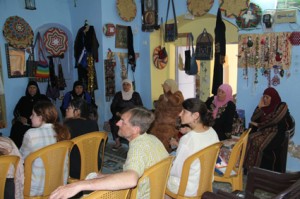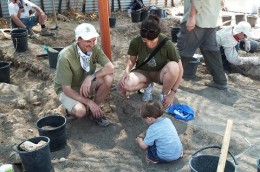Whenever I visualize what a typical archaeologist looks like, what comes to mind is a nerdy, white male, shovel in hand, wearing a sunhat and those pants that zip off at the knee. Although this image may be specific to me, I’m sure that many people’s visual representations of an archaeologist would share one aspect in common with mine: the male gender. Women have only fairly recently been admitted into the field of archaeology, yet, this imbalance in the field isn’t the only way in which women have been overlooked- ancient women themselves have been unfairly overlooked in archaeology, therefore being left behind in the archaeological record.
In the 1960s emerged feminist archaeology, which seeks the gendered experiences of the past through three objectives: first, to expose and correct the male bias in archaeology; second, to balance the imbalance of women’s professional participation in archaeology; and third, to spotlight the roles of women in the past. An archaeological site in Israel serves as a perfect example that incorporates these three objectives into its excavation.
Excavation at Tel Abel Beth Maacah began because it was referenced in the Bible and holds the potential to inform us about northern Israel during the Bronze and Iron Ages. In 2014, Dr. Naama Yahalom-Mack, Dr. Nava Panitz-Cohen, and Prof. Lauren Monroe (all female archaeologists) implemented the “Gender Agenda” program at the site. The “Gender Agenda” served to excavate with the sole purpose of identifying engendered activities such as locating cooking and grinding areas, ovens, pottery, etc. Students a part of the “Gender Agenda” program learned how to collect samples for micro-archaeological analysis that can be used for understanding diet, modes of economic production and how activities were carried out within the home sphere, and other aspects of daily life. Students also conducted an ethnographic study by visiting and interacting with local Arab women at the Center for Women’s Traditional Crafts in a nearby village. By explicitly searching for the physical remains of women’s day-to-day lives, the archaeologists behind the “Gender Agenda” validate the often-marginalized history of women in antiquity. Women’s history was often overlooked because their activities weren’t believed to have contributed anything important to the society since they served as rulers of the private, home sphere. The archaeologists at Tel Beth Abel Maacah recognize the contributions that women add to society through their search for engendered activities.
Why is a focus on gender so important? Some argue that since gender assignments are untestable to a certain extent, then therefore gender is irrelevant in the archaeological record. This is not true. By analyzing and interpreting the gender roles established by a society we can get an overview of the social organization and structure of the society. Most importantly, we are acknowledging every person, rather than overlooking a group of people, and looking to understand their individual function within the society.
Additional Links:
http://www.biblicalarchaeology.org/daily/digs-2014/gender-in-archaeology-at-abel-beth-maacah/
Sources Used:
http://www.abel-beth-maacah.org/index.php/12-seasons/2013-season/78-gender-agenda
Photos:
http://www.biblicalarchaeology.org/daily/digs-2014/gender-in-archaeology-at-abel-beth-maacah/
http://www.abel-beth-maacah.org



The Tel Abel Beth Maacah excavation reveals how much can be gained from studying the everyday. Looking into tasks and activities often deemed “mundane” and “insignificant” actually reveals significant information about life for women at this time/the society as a whole. This research into the past encourages recognition of not only the importance of women in antiquity, but also today. I find it fascinating, that as part of this mission, the students “also conducted an ethnographic study by visiting and interacting with local Arab women at the Center for Women’s Traditional Crafts in a nearby village.” Why did they carry out this ethnographic research and in what ways did it impact their archaeological fieldwork? Did it influence their analysis of the archaeological site and ancient society? Did it function as a public act of recognition of the value of the knowledge women hold?
I attended several conference sessions on feminist and queer archaeology last year. Queer archaeology goes beyond looking at a gender binary of male vs female. When did this binary begin? Archaeology and anthropology in general show us that many cultures had additional genders that American culture long ignored.
The gender binary is the traditional view that divides humans into 2 strict categories: the male and the female. It has become so ingrained in society, that it isn’t recognized as an ideology. The binary began with the categorization of hunters and gatherers because this was the first distinction and divide between the two sexes. Women were grouped as gatherers, and men as the hunters, characterizing and gendering the two groups. This binary has been translated into a new context in modern society: women are still to behave as the “gatherers” by functioning as homemakers and housewives in the private, domestic sphere and men are to continue their role as hunters by functioning as workers in the public sphere. We can see how this binary has adapted over time and strongly functions today. In the 1990s emerged queer theory, which was soon incorporated into the practice of archaeology to seek understanding of cultures that went beyond the gender binary of male and female. Many culture’s believed in a third sex, and they expressed this in very different ways. For example, in the Roman cult of Cybele, male participants castrated themselves to become the Galli, the third sex. However, such additional genders have been overlooked because of the strict gender binary. Queer archaeology makes it its mission to uncover the rich, complex sexual politics of the past.
http://ieet.org/archive/IEET-03-PostGender.pdf